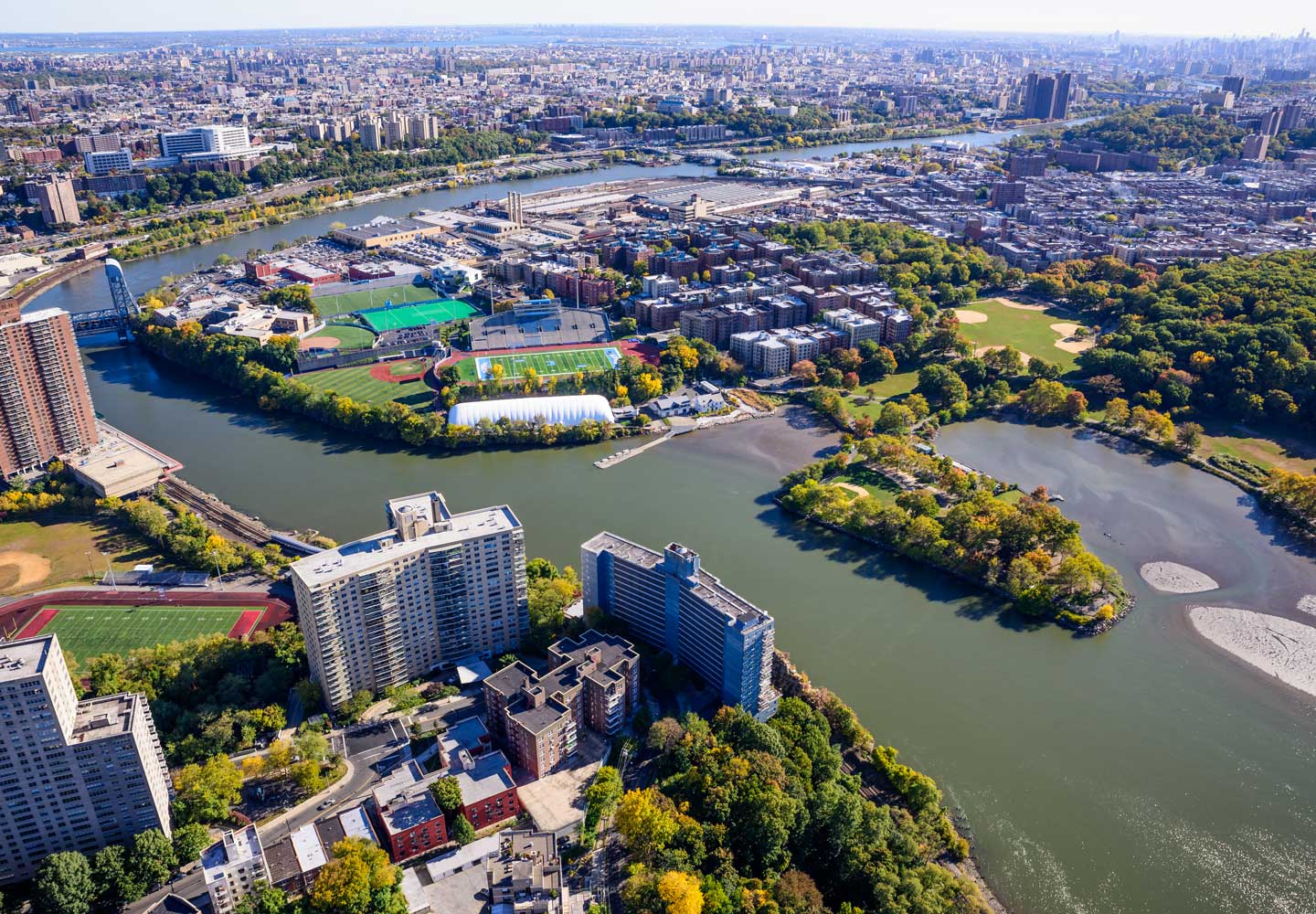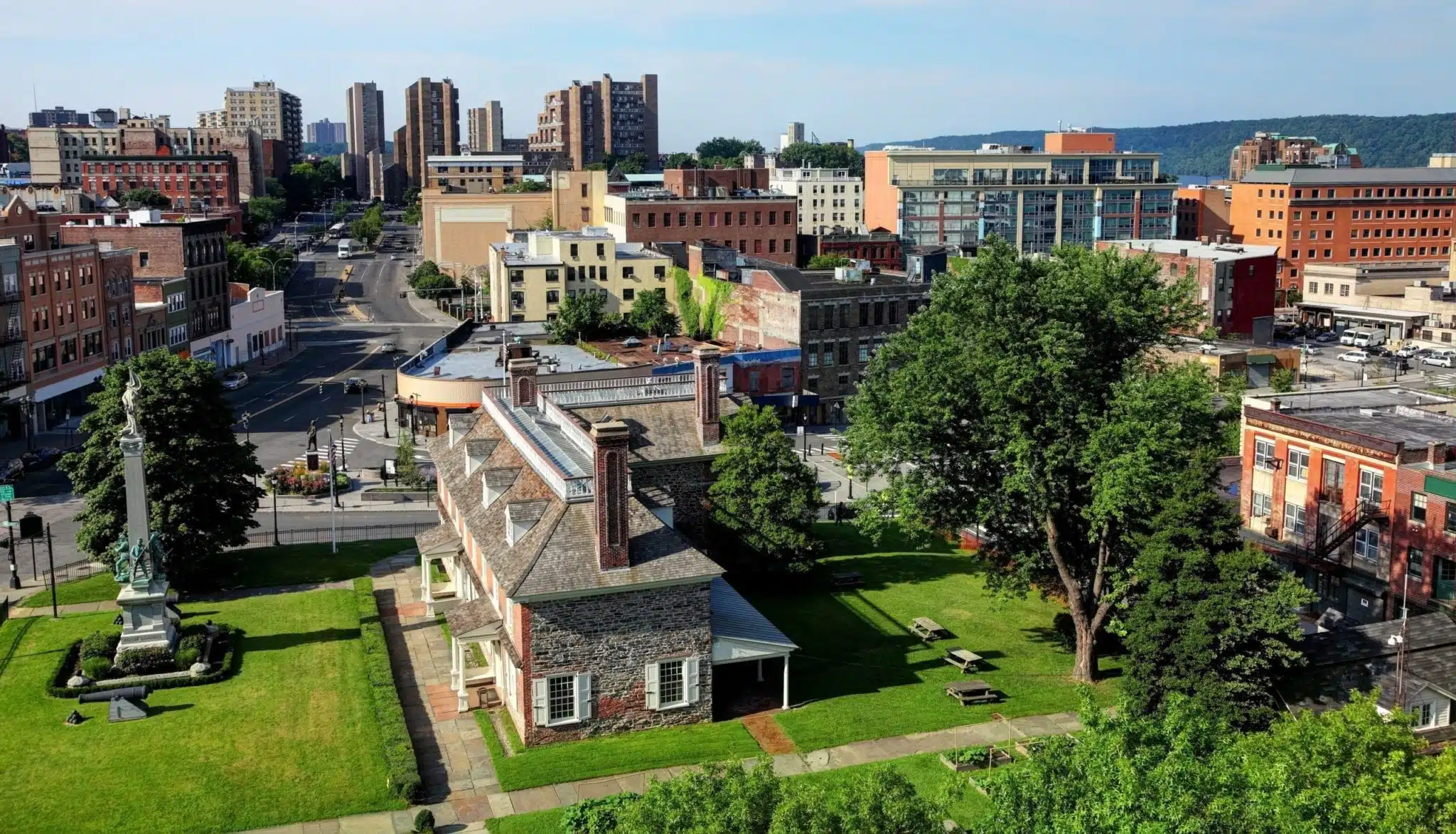How Do People Afford To Live in NYC?
New York StateNew York City

How do people afford to live in NYC? New residents of the Big Apple — and those wanting to be new residents — ask themselves this question often, especially once they discover that living expenses in NYC are significantly higher than in other cities where they’ve lived. It’s worth noting that just leaving your apartment can feel like money is mysteriously deleted from your checking account.
How did I spend $14 on transportation today? I took the subway . . .
Wait, that salad was how much?
Did my bodega overcharge me?
The good news? Even though it’s notoriously expensive, living in NYC on a budget is doable. And you don’t have to wait until the fourth or fifth accidental Uber surge pricing ride to approach that dreaded B word and get serious about figuring out how to budget in NYC.
Whether you’ve been in NYC a while or you’re trying to plan ahead for your move, collecting tips for how to save money in NYC is always smart. Read on for information about the cost of living in New York City, how to save on living expenses, how to find rent-stabilized apartments in NYC, the cheapest boroughs in NYC, and other general tips on living in NYC on a budget.
| Planning a move to NYC? Start by getting a quote from PODS. |
How Much Does It Cost To Live in NYC?
If you’re looking at moving to New York or have moved there recently, you’ve probably found yourself wondering how to afford the cost of living in NYC, as it might seem like money is disappearing from your bank account at a much quicker clip than you’re used to. It’s not your imagination: Living expenses in NYC are genuinely higher than in other cities.
By how much, you ask? Well, that depends on where you’re moving from. Venturing from San Francisco, L.A., San Jose, or international cities like London, you may not notice the shift much beyond your housing costs. If you’re relocating from Portland, Oregon, or Asheville, North Carolina? Ouch. You’ll be feeling the pain in your wallet. According to RentCafe, the cost of living in New York City, NY, is 41 percent higher than the state average and 77 percent higher than the national average. What’s more, housing is a whopping 238 percent more expensive than the U.S average!
How Much Do You Need To Make To Live in NYC?
Is $300,000 enough to live in NYC? If this is your annual salary, you should be A-OK in any borough. This isn’t even close to the average American salary, though, so you may be wondering how people afford to live in NYC on a smaller paycheck.
The salary you need to live in NYC varies, of course, depending on your personal lifestyle. According to the MIT Cost of Living calculator, however, the required annual income before taxes for a single adult living in NYC is $69,282. For a working couple with two children, that number goes up to $159,188.
|
Q: Can you live on $50,000 a year in NYC?
|

Living in NYC on a budget means forgoing taxis and Ubers for walking, biking, and public transit — a one-way subway ticket will cost you $2.90.
Cost of Living in NYC — The Breakdown
How do people afford to live in NYC with its high cost of living? This can be a complicated question to answer because New York isn’t just one city — it’s more like five cities, with a host of diverse neighborhoods. Get to know what each has to offer with our guide to the New York City boroughs. Living in the heart of a more expensive part of Manhattan will mean much higher rent than choosing a less accessible or central area of Brooklyn or Queens.
Here’s a quick cost comparison of average living expenses in NYC compared to the national average:
NYC Rent
According to RentCafe, average rent for a one-bedroom apartment is around $4,575 per month, compared to a national average closer to $1,750. Yes, more than 2.5 as much is pretty extreme. In Manhattan, luxury areas drive average prices even higher, close to $4,950 per month, while Brooklyn’s average is around $3,700. Average rent in the outer boroughs of Staten Island, the Bronx, and Queens will help you save significantly if you’re willing to sacrifice living in the heart of the city.
NYC Transportation
- NYC Metro Pass: $132/month
- Comparable Transit Passes (Other Cities): L.A. $18/week, Chicago $75/month
When learning how to live in New York on a budget, note that your transportation costs will depend greatly on whether you choose to have a car in New York. Inner boroughs are especially low on street parking, and a garage will cost you a pretty penny. Most residents choose public transit for commuting to and from work. A single ride is $2.90, making a round trip $5.80. Many commuters opt for an unlimited monthly pass for $132, which works out to about $4.40 a day. These transit costs run a little higher than in many other cities. Tip: you may qualify for a reduced fare if you have a lower income. Check out the MTA website to learn more.
NYC Groceries
Yes, even food costs more in the Big Apple. You can expect to pay almost $500 a month on groceries, which is just over $160 more a month than the national average. Can you save in this area? Of course. But you’ll want to be vigilant about meal planning, comparing prices, and avoiding last-minute purchases at your corner bodega.
NYC Utilities
As far as your basic utilities go, you can expect costs to stay pretty consistent with national averages — about $200 a month for the usual 900-square-foot apartment utilities (electricity, water, garbage). Internet costs in New York are close to the national average, as well, with monthly rates averaging around $65.
| Q: What is a realistic budget for NYC? A: This, of course, varies, based on your lifestyle. For starters, though, if you’re taking into account basic factors such as rent (assuming you’re living with roommates or in a no-frills studio in a more affordable neighborhood), groceries, transportation, and NYC taxes, you’ll need to budget at least $4,000 a month for your basic needs listed above and then some. According to the MIT Cost of Living calculator, the required annual income before taxes for a single adult living in NYC is $69,282. |

How do people afford to live in NYC? Often, they rent an apartment in the cheapest borough in NYC.
What Is the Cheapest Borough in NYC?
As you consider how to save money in New York, you might be wondering about other popular boroughs like Brooklyn, The Bronx, and Queens. As in Manhattan, NYC boroughs offer a broad range of neighborhoods with varying rent prices and even differences in restaurant and grocery store pricing.
As you consider living expenses in NYC and the potential of moving to Brooklyn or another borough, make sure you consider the cost of your commute, as well. If you’re committed to a job in Manhattan, you’re guaranteed to be spending more on transportation as opposed to saving by walking or biking in the city.
Here are the cheapest boroughs in NYC and their cost of living score. Keep in mind that the national average is 100, and the Manhattan cost of living is 204.1.
If you’re comfortable with a longer commute into the city, one of these 11 cities near NYC will have you close-ish to the action at a much lower price tag.
| Wondering how your city compares? Check out this cost of living comparison calculator from NerdWallet, which shows how cost of living inflates or deflates by city. |
How To Afford Living in NYC
The number one way to navigate living in NYC on a budget? Find ways to lower your housing cost. For most, rent is far and away the most expensive part of living in New York City. Certain parts of NYC — particularly a few neighborhoods in Manhattan and Brooklyn — are simply prohibitively expensive, and there’s not much getting around it.
How do people afford to live in NYC if they absolutely must live on the Upper West Side or Park Slope (perhaps due to a job or other constraint)? They likely have a roommate or two! This dramatically decreases the cost of rent and utilities. Operating on a shoestring? Research whether you may qualify for New York’s affordable housing program through the NYC Housing Connect.
If you’re setting out to find an affordable neighborhood in NYC or looking for the cheapest borough in NYC, here are a few things to know.
Approximate Average Rent by Borough*:
- Manhattan: $4,950
- Brooklyn: $3,700
- Queens: $3,050
- The Bronx: $1,900
- Staten Island: $1,625
*Across neighborhoods and all housing types.
As you can see, right off the bat you can save a boatload on rent by choosing to live in an outer borough like Queens or The Bronx, while Staten Island is the cheapest place to live in NYC when it comes to picking one of the five boroughs. If you’re willing to sacrifice a bit of commute time in favor of saving money (and potentially having more space!), looking outside Manhattan and even Brooklyn may be a great choice for you.

Flushing is a vibrant, diverse community with a unique mix of high-rise buildings and single-family homes.
Approximate Average Rent by Borough*:
A big part of figuring out how to afford living in NYC is finding the right neighborhood for you (and your budget). Not sure where to start your search? Here are some of the cheapest places to live in New York City and the outer boroughs.
1. Washington Heights (Manhattan)
- Average rent (one-bedroom): $2,625
While it may not be the absolute cheapest place to live in NYC, if you’re set on living in Manhattan, consider relocating to Washington Heights — an area filled with a notable percentage of rent-stabilized apartments. Not only is Washington Heights the cheapest area of Manhattan, but it’s also known for its lush greenery and community feel. Wondering why it’s so affordable? This is likely because it’s far from downtown and does not contain as many city amenities, like restaurants and popular grocery stores, as other neighborhoods.
2. Bergen Beach (Brooklyn)
- Average rent (one-bedroom): $1,825
Think you can’t enjoy the beach life in NYC? Think again — and you can do it while living on a budget. Bergen Beach isn’t the trendiest area of Brooklyn, and you will have to endure a pretty long commute to get into the city, but it does come with rent prices that are much lower than the NYC average. If you want a more traditional neighborhood feel, though, you’ll likely enjoy Bergen Beach’s tree-lined streets and parks.
3. Flushing (Queens)
- Average rent (one-bedroom): $2,175
Forget what you think you know about Queens — Flushing is a vibrant, diverse community with a unique mix of high-rise buildings and single-family homes. This variety is one of the reasons why living in Flushing is considered affordable; it’s a law of averages. There are older buildings that boast a reasonable monthly rate, but newer luxury developments are coming into the area and feature higher prices.
More of the Cheapest Places To Live in NYC:
- Bay Ridge (Brooklyn)
- Flatbush (Brooklyn)
- Sunnyside (Queens)
- Country Club (The Bronx)
- All areas of Staten Island
How To Find Rent-Stabilized Apartments in NYC
If you’ve been searching for advice on how to afford living in NYC or how to budget in NYC, you’ve likely come across terms like “rent-stabilized” or “rent-controlled.” If you’re unfamiliar with these terms, here’s a quick history lesson. It’ll help you determine how some people afford to live in NYC.Back in the 1940s, then-President Franklin D. Roosevelt enacted the Emergency Price Control Act so landlords couldn’t unfairly raise rent prices for their tenants during the financial strain of World War II. After the war ended, these regulations changed somewhat, but rent stabilization remains in effect today, and the state and local governments oversee the regulations.
Figuring out how to find a rent-stabilized apartment in NYC means knowing where to look. Here are some common requirements for rent-controlled apartment buildings:
- Contains six or more units
- Was built before 1974
- Is not a co-op or condo
Of course, there are exceptions to these rules. And just because a building meets these requirements doesn’t mean that the units are rent-stabilized. The only way to know for sure if an apartment is rent-stabilized is to contact NYC Homes and Community Renewal. You can also use the HCR web portal.
| Q: Can I move to NYC without a job? A: How do people afford to live in NYC if they don’t have a job lined up? While you can theoretically move to NYC without a job, it’s important to know that the job market is pretty competitive. Ideally, you’ll move with a buffer of several months of savings, giving yourself plenty of time to land a new gig. And, in the meantime, sticking to a budget (and likely living with roommates) will be key to making sure you can pay rent each month. |

Grocery shopping in New York City is not one-size-fits-all. Check out your local farmers markets and street vendors for produce instead of heading to a store.
Top Tips for How To Afford Living in NYC
Now that you have an idea about how much it costs to live in NYC, you’re probably asking yourself, “How do people afford to live in NYC?” You may be beginning to doubt if living on a budget in NYC is even possible. Or have you resigned yourself to just living in NYC until you go broke, then moving back in with your parents in Ohio?
While there’s no getting around the fact that New York is expensive, figuring out how to afford living in NYC isn’t impossible, and you can definitely learn how to save money in NYC!
Here are several quick tips for reducing your overall budget in New York.
1. Don’t Bring Your Car.
Heading to the Big Apple? You may want to ditch your car. Living in NYC means that not only is parking extremely scarce and a total hassle in most areas of the city (you’ll pay an arm and a leg for a space), but the city is also well connected via public transit. Save major bucks on insurance, gas, repairs, and parking by selling your wheels before you arrive. Check out Yelp reviews for car-sharing services like Zipcar for those occasional times when you really need a car or just want to get away from the city.
2. Do the Math on Transportation Costs.
Speaking of transportation, before you spring for a monthly unlimited Metro Pass, actually sit down and calculate how often you’re taking the subway and bus. If you work from home a few days a week, it may be worth it to continue paying ride-by-ride. Or perhaps it’s the opposite — you’re constantly riding the train to commute and get together with friends. You may find those unlimited rides will save you significant cash.
3. Shop at Local Markets for Cheaper Produce.
Grocery shopping in New York City is not one-size-fits-all. Start exploring local farmers markets and street vendors for produce instead of heading to a store for every purchase. An extra stop could save you big!
4. Skip the Taxis and Ubers.
This may be obvious for any budget post, but try to avoid taxi, Uber, and Lyft rides, no matter how tempting. This is one huge tip for how to save money living in NYC, as those surge prices can add up quickly! Living in NYC means getting very familiar with the trains, or try walking or biking if you’re sick of the subway. Bonus: Save by not having to go to the gym!
5. Join the Sharing Economy.
In a city as dense as New York, people are coming and going and purging possessions all the time. Join your local Buy Nothing group on Facebook or get apps like NextDoor, where people around you often post items they’re unloading for free.
6. Make Dining Out a Treat, Not a Default.
We know, we know — after your long train ride home, the last thing you want to do is cook a meal, especially when the Seamless app is right there on your phone with your debit card preloaded. But as you know, dinners out or ordered in can add up quickly before you’ve realized what happened. Focus on stocking up on staples at the grocery store, so there’s always something quick and easy to make at home. Oh, and if you’re truly living in NYC on a budget, you may want to just go ahead and delete that Seamless app.
Living in NYC on a budget can be challenging. But that’s all it is: a challenge that you can tackle with a few simple tactics and strategies. Find a neighborhood you can afford, commit to a few money-saving behaviors, and create your own version of what “living large” looks like in New York — as in having a larger savings account.
Looking for more tips on moving to New York? Check out our other guides about how to live in New York on the PODS Blog, like finding an apartment in NYC, NYC suburbs, NYC moving costs and options, and how to survive moving day in NYC without going crazy.
Bonnie Azoulay Elmann is an NYC-based freelance writer and frequent contributor to the PODS Blog. Her work has appeared in Glamour, Health, and Parents, among others. She is an extremely driven digital storyteller who may or may not have a slight obsession with fanny packs.
Editor’s note: Average monthly rent prices were obtained from RentCafe. For ease of reading, monthly rental prices were rounded to the nearest $25.

Your quote in 60 seconds
Get pricing tailored to your needs!








